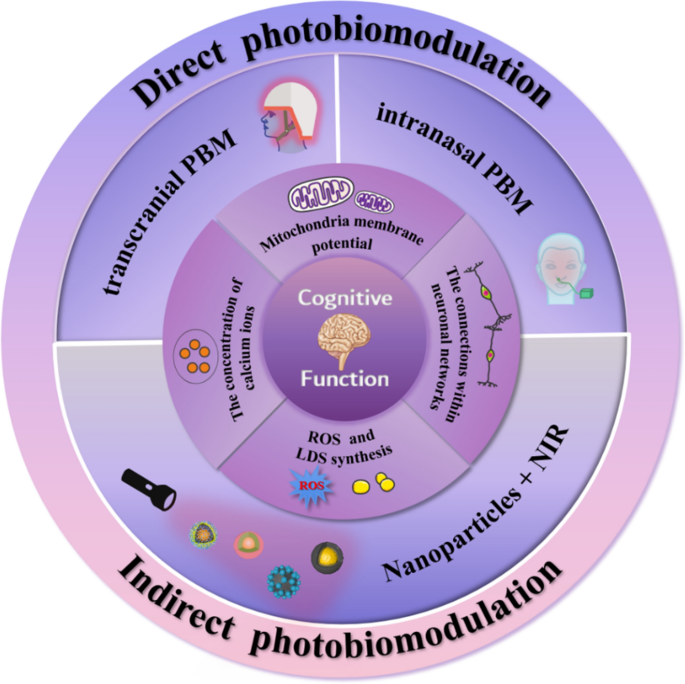Photobiomodulation Fundamentals Explained
Wiki Article
See This Report on Photobiomodulation
Table of ContentsThe smart Trick of Photobiomodulation That Nobody is DiscussingThe smart Trick of Photobiomodulation That Nobody is Talking AboutPhotobiomodulation - The FactsEverything about Photobiomodulation
Laser treatment is a medical therapy that utilizes concentrated light to stimulate a procedure called. Throughout PBM, photons go into the tissue and connect with the cytochrome c facility within mitochondria. This communication causes a biological cascade of occasions that brings about an increase in mobile metabolic process, which can in addition to speed up the recovery procedure.There is consensus that the application of a therapeutic dose of light to impaired or useless cells leads to a mobile action mediated by mitochondrial mechanisms. Photobiomodulation. Research studies have actually revealed that these changes can influence discomfort and swelling, as well as, tissue repair
Modifications in ATP, reactive oxygen types and nitric oxide comply with light absorption by Cc, O. These impacts are redox state and dose reliant.

Facts About Photobiomodulation Revealed
PBM tools have been cleared for advertising and marketing by FDA through the Premarket Notification/510( k) procedure as adjunctive gadgets for the short-lived alleviation of discomfort. These clearances were based on the presentation of scientific information to sustain such claims (Photobiomodulation). In this therapy, a light is put near or in contact with the skin, permitting the light power (photons) to pass through tissue where it interacts with chromophores found in cells causing photophysical and photochemical changes that lead to modifications at the molecular, mobile and tissue degrees of the bodyRemarkably, recent research study shows that light can boost efficiency in typical tissues and cells. The possible applications of PBMT are many and are being checked out experimentally at the fundamental scientific research, pre-clinical and medical degree. The current clinical usages are for the alleviation of pain and swelling and the treatment of sporting activities injuries.

The therapy criteria and number of sessions needed for PBMT are reliant upon location and reason. PBMT normally calls for even more than one treatment for ideal pain relief.
Rumored Buzz on Photobiomodulation
Therapy criteria for PBMT were originally developed using cells in vitro and in tiny animal versions. These therapy criteria usually had a low irradiance and fluence and worked well for cutaneous applications. Nonetheless when clinicians began to make use of PBMT to deal with structures that were located deeper in the body, they made use of these specifications with unfavorable results.
We now understand that these negative research studies resulted from incorrect gadget and therapy criteria for transcutaneous sites treatment of deeper structures. Current breakthroughs in laser therapy tools and more study into the proper dosages have actually dramatically improved the outcomes of PBMT. For treating deep cells, the wavelength of light made use of figures out the depth of infiltration into a cells.
Consequently, it is essential that a clinician makes use of the proper wavelength of light and parameters to treat a problem. One wavelength and one collection of therapy parameters will certainly not work for all conditions. Unfavorable negative effects have not been reported from making use of PBMT (Photobiomodulation). Updated June 27, 2016Juanita j
Light treatment is a non-invasive treatment that works by increasing the capability of the cell to produce energy (ATP) to heal the area being dealt with. Because of this, it can reduce inflammation, swelling, and pain in the location. Research in this location is increasing, with even more extensive research study documents linked listed below for those who wish to discover more.
Facts About Photobiomodulation Revealed
In the initial experiment, Dr. Endre Mester, made use of shaved rats and observing exactly how the laser impacted their ability to grow hair compared to the group that was not obtaining LLLT. He found that the group of computer mice getting LLLT had the ability to expand their hair back more swiftly than the group of mice that really did not obtain LLLT (Hoon C, et alia; 2012).This treatment is labelled in this manner to differentiate the difference in between the lasers some careers make use of to reduce (eg. in surgeries, or dental treatments). Low-level light therapy is pain-free, non-invasive therapy. It is utilized to decrease swelling, swelling, and persistent joint disorders, reduce discomfort and speed up injury healing of nerves and tissues (Hoon C, et al; 2012).
LLLT has a biphasic action, Continued indicating that lower doses are typically attended be more valuable than higher doses. That being stated, dosages higher or less than the ideal dose doesn't affect (Hoon C, et alia; 2012). Therefore, it can be challenging to have research studies on LLLT with a lot of parameters.
Some firms combined both (LED and laser) to provide a more news well-shaped therapy because lasers can permeate deeper than LED and infrared light (Norman Doidge, The Mind's Means of Recovery, 2015). During treatment, the area that is being dealt with is exposed to LED light from a Bio, Flex Laser, which goes to 660 nm wavelength, complied with by infrared light at 830-840 nm wavelength.
Report this wiki page